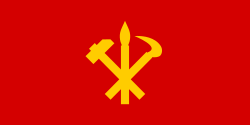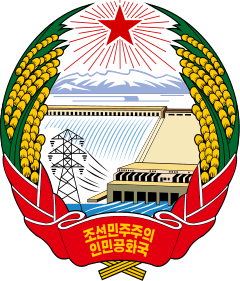Chairman of the Workers' Party of Korea
The Chairman of the Workers’ Party of Korea (Korean: 조선로동당 위원장) is the head of the Workers’ Party of Korea (WPK), the ruling political party in North Korea. Party Chairman is the first priority political position of Supreme Leader.[1]
| Chairman of the Workers' Party of Korea 조선로동당 위원장 | |
|---|---|
 Logo of the Workers' Party of Korea | |
 Flag of the Workers' Party of Korea | |
| Workers' Party of Korea | |
| Type | Party leader Supreme leader |
| Residence | Forbidden City |
| Seat | Pyongyang |
| Nominator | WPK Congress |
| Appointer | WPK Congress |
| Term length | No fixed term |
| Constituting instrument | WPK Charter |
| Inaugural holder | Kim Tu-bong |
| Formation | 28 August 1946 |
| Deputy | Vice Chairman |
| Chairman of the Workers' Party of Korea | |
| Hangul | 조선로동당 위원장 |
|---|---|
| Hanja | |
| Revised Romanization | Joseon Rodongdang Wiwonjang |
| McCune–Reischauer | Chosŏn Rodongdang Wiwonjang |
The Charter of the Workers’ Party of Korea states the WPK Chairman is the supreme leader of the WPK. The Party Congress nominates and elects the WPK Chairman. The Party Conference is also able to nominate and elect the WPK Chairman. The WPK Chairman serves as the ex officio Chairman of the Central Military Commission of the Workers’ Party of Korea. In practice, the WPK Chairman is also a member of the Presidium of the Political Bureau and the head of the Executive Policy Bureau.
The current chairman of the Workers’ Party of Korea is Kim Jong-un, who took office on 9 May 2016.
History
The position was first established as the Chief Secretary of the North Korea Bureau of the Communist Party of Korea (Korean: 조선공산당 북조선분국 책임비서) on 13 October 1945 during the conference of Communist Party of Korea members in northern Korea. Kim Yong-bom was elected as the first chief secretary. He was succeeded by Kim Il-sung, who was elected as chief secretary on 18 December 1945 at the third enlarged executive committee meeting of the North Korea Bureau of the Communist Party of Korea.
On 28 August 1946, the North Korean Bureau of the Communist Party of Korea and the New People’s Party of Korea were merged to form the Workers’ Party of North Korea during its 1st Congress. The position of Chairman of the Central Committee of the Workers’ Party of North Korea (Korean: 북조선로동당 중앙위원회 위원장) was also created to lead the new party. Kim Tu-bong, the chairman of the New People’s Party of Korea, was elected as the chairman and was re-elected in March 1948 during the 2nd Congress.
On 30 June 1949, the Workers’ Party of North Korea and the Workers’ Party of South Korea merged to form the Workers’ Party of Korea. The position of Chairman of the Central Committee of the Workers’ Party of Korea (Korean: 조선로동당 중앙위원회 위원장) was also created. Kim Il-sung, who was a vice chairman of the WPNK central committee, was elected as chairman and was re-elected in April 1956 during the 3rd WPK Congress and in September 1961 during the 4th WPK Congress.
On 12 October 1966, the position of General Secretary of the Central Committee of the Workers’ Party of Korea (Korean: 조선로동당 중앙위원회 총비서) was created at the 14th plenary meeting of the 4th WPK Central Committee. Kim Il-sung was elected by the meeting as general secretary and was re-elected in November 1970 at the 5th WPK Congress and in October 1980 at the 6th WPK Congress.
Kim Il-sung held the position of general secretary until his death on 8 July 1994. Following this, the post was left vacant until 1997.
From late September until early October 1997, conferences of various WPK organizations were held to recommend the election of Kim Jong-il as general secretary. Kim Jong-il is the designated successor of Kim Il-sung. At that point, Kim Jong-il held the party positions of Political Bureau Presidium member and WPK central committee secretary.
On 8 October 1997, the Central Committee and the Central Military Commission issued a special communique stating that Kim Jong-il was elected to the position of General Secretary of the Workers’ Party of Korea (Korean: 조선로동당 총비서).
On 28 September 2010, Kim Jong-il was re-elected as WPK general secretary at the 3rd WPK Conference. The conference also amended the Charter of the Workers’ Party of Korea to state that the WPK general secretary is the ex officio Chairman of the Central Military Commission of the Workers’ Party of Korea.
Kim Jong-il died on 17 December 2011 and the position of general secretary was left vacant.
The WPK held its 4th Conference on 11 April 2012. It declared Kim Jong-il as the eternal General Secretary of the Workers’ Party of Korea (Korean: 영원한 조선로동당 총비서). The WPK Charter was revised to create the First Secretary of the Workers’ Party of Korea (Korean: 조선로동당 제1비서) as the new highest party position.
Kim Jong-un was elected as first secretary on 11 April 2012 during the 4th WPK Conference. Kim Jong-un is the designated successor of Kim Jong-il. Prior to his election as WPK first secretary, Kim Jong-un held the party positions of Central Military Commission vice chairman and Central Committee member.
On 9 May 2016, the 7th WPK Congress created the Chairman of the Workers’ Party of Korea as the new highest party position. Kim Jong-un was elected by the congress as the WPK chairman.
 |
|---|
| This article is part of a series on the politics and government of North Korea |
|
|
|
|
|
|
Related topics
|
|
|
Office holders
| Chief Secretary of the North Korea Bureau of the Communist Party of Korea 조선공산당 북조선분국 책임비서 朝鮮共產黨 北朝鮮分局 責任秘書 | ||||
|---|---|---|---|---|
| Chief Secretary | Term | Election | ||
| Kim Yong-bom 김용범 1902–1947 |
13 October 1945 | 18 December 1945 | - | |
 |
Kim Il-sung 김일성 1912–1994
|
18 December 1945 | 31 August 1946 | - |
| Chairman of the Central Committee of the Workers' Party of North Korea 북조선로동당 중앙위원회 위원장 北朝鮮勞動黨 中央委員會 委員長 | ||||
| Chairman | Term | Election | ||
| Kim Tu-bong 김두봉 1889–1958 |
31 August 1946 | 30 March 1948 | 1st Central Committee | |
| 30 March 1948 | 30 June 1949 | 2nd Central Committee | ||
| Chairman of the Central Committee of the Workers' Party of Korea 조선로동당 중앙위원회 위원장 朝鮮勞動黨 中央委員會 委員長 | ||||
| Chairman | Term | Election | ||
 |
Kim Il-sung 김일성 1912–1994 |
30 June 1949 | 29 April 1956 | 2nd Central Committee |
| 29 April 1956 | 18 September 1961 | 3rd Central Committee | ||
| 18 September 1961 | 12 October 1966 | 4th Central Committee | ||
| General Secretary of the Central Committee of the Workers' Party of Korea 조선로동당 중앙위원회 총비서 朝鮮勞動黨 中央委員會 總秘書 | ||||
| General Secretary | Term | Election | ||
 |
Kim Il-sung 김일성 1912–1994 |
12 October 1966 | 13 November 1970 | 4th Central Committee |
| 13 November 1970 | 14 October 1980 | 5th Central Committee | ||
| 14 October 1980 | 8 July 1994 | 6th Central Committee | ||
| Vacant (8 July 1994–8 October 1997) | ||||
| General Secretary of the Workers' Party of Korea 조선로동당 총비서 朝鮮勞動黨 總秘書 | ||||
| General Secretary | Term | Election | ||
.jpg) |
Kim Jong-il 김정일 1941–2011 |
8 October 1997 | 28 September 2010 | 6th Central Committee |
| 28 September 2010 | 17 December 2011 | |||
| Vacant (17 December 2011–11 April 2012) | ||||
| First Secretary of the Workers' Party of Korea 조선로동당 제1비서 朝鮮勞動黨 第1秘書 | ||||
| First Secretary | Term | Election | ||
.jpg) |
Kim Jong-un 김정은 born 1983 |
11 April 2012 | 9 May 2016 | 6th Central Committee |
| Chairman of the Workers' Party of Korea 조선로동당 위원장 朝鮮勞動黨 委員長 | ||||
| Chairman | Term | Election | ||
.jpg) |
Kim Jong-un 김정은 born 1983 |
9 May 2016 | Present | 7th Central Committee |
Eternal General Secretary
| Name (birth–death) |
Portrait | Designated |
|---|---|---|
| Kim Jong-il (1941–2011) |
.jpg) |
11 April 2012 |
Vice Chairmen
Vice Chairmen of the party are: Pak Kwang-ho, Pak Thae-song, Thae Jong-su, An Jong-su, and Choe Hwi.[2]
References
Footnotes
- "Supreme Leader Kim Jong Un Cuts Tape for Completion of Sunchon Phosphatic Fertilizer Factory". Kim Il-sung University. Korean Central News Agency (KCNA). 2 May 2020. Retrieved 2 May 2020.
Kim Jong Un, chairman of the Workers' Party of Korea (WPK), chairman of the State Affairs Commission of the Democratic People's Republic of Korea and supreme commander of the armed forces of the DPRK, attended the ceremony.
- "Second Plenum of Seventh WPK Central Committee". KCNA. 8 October 2017. Retrieved 1 February 2019.
Bibliography
Articles, books and journal entries
- Haggard, Stephen; Herman, Luke; Ryu, Jaesung (July–August 2014). "Political Change in North Korea: Mapping the Succession". Asian Survey. University of California Press. 54 (4): 773–780. doi:10.1525/as.2014.54.4.773. JSTOR 10.1525/as.2014.54.4.773.
- Kim, Nam-Sik (Spring–Summer 1982). "North Korea's Power Structure and Foreign Relations: an Analysis of the Sixth Congress of the KWP". The Journal of East Asian Affairs. Institute for National Security Strategy. 2 (1): 125–151. JSTOR 23253510.
- Staff writer (2012–2014). Understanding North Korea. Ministry of Unification.
Books
- Buzo, Adrian (1999). The Guerilla Dynasty: Politics and Leadership in North Korea. I.B. Tauris. ISBN 1860644147.
- Frank, Rüdiger (2013). "North Korea in 2012: Domestic Politics, the Economy and Social Issues". Korea 2013: Politics, Economy and Society. BRILL Publishers. ISBN 9004262970.
- Gause, Ken E. (2011). North Korea Under Kim Chong-il: Power, Politics, and Prospects for Change. ABC-CLIO. ISBN 0313381755.
- — (2013). "The Role and Influence of the Party Apparatus". In Park, Kyung-ae; Snyder, Scott (eds.). North Korea in Transition: Politics, Economy, and Society. Rowman & Littlefield. pp. 19–46. ISBN 1442218126.CS1 maint: ref=harv (link)
- Kim, Samuel (2000). "North Korean Informal Politics". Informal Politics in East Asia. Cambridge University Press. ISBN 0521645387.
- Lankov, Andrei (2002). From Stalin to Kim Il Song: The Formation of North Korea, 1945–1960. C. Hurst & Co. Publishers. ISBN 1850655634.
- Lankov, Andrei (2007). Crisis in North Korea: The Failure of De-Stalinization, 1956. University of Hawaii Press. ISBN 0824832078.
- Suh, Dae-sook (1988). Kim Il Sung: The North Korean Leader (1st ed.). Columbia University Press. ISBN 0231065736.
- Yŏnʼguso, Pʻyŏnghwa Tʻongil (1997). Korea and the World. University of California. Research Center for Peace and Unification.
